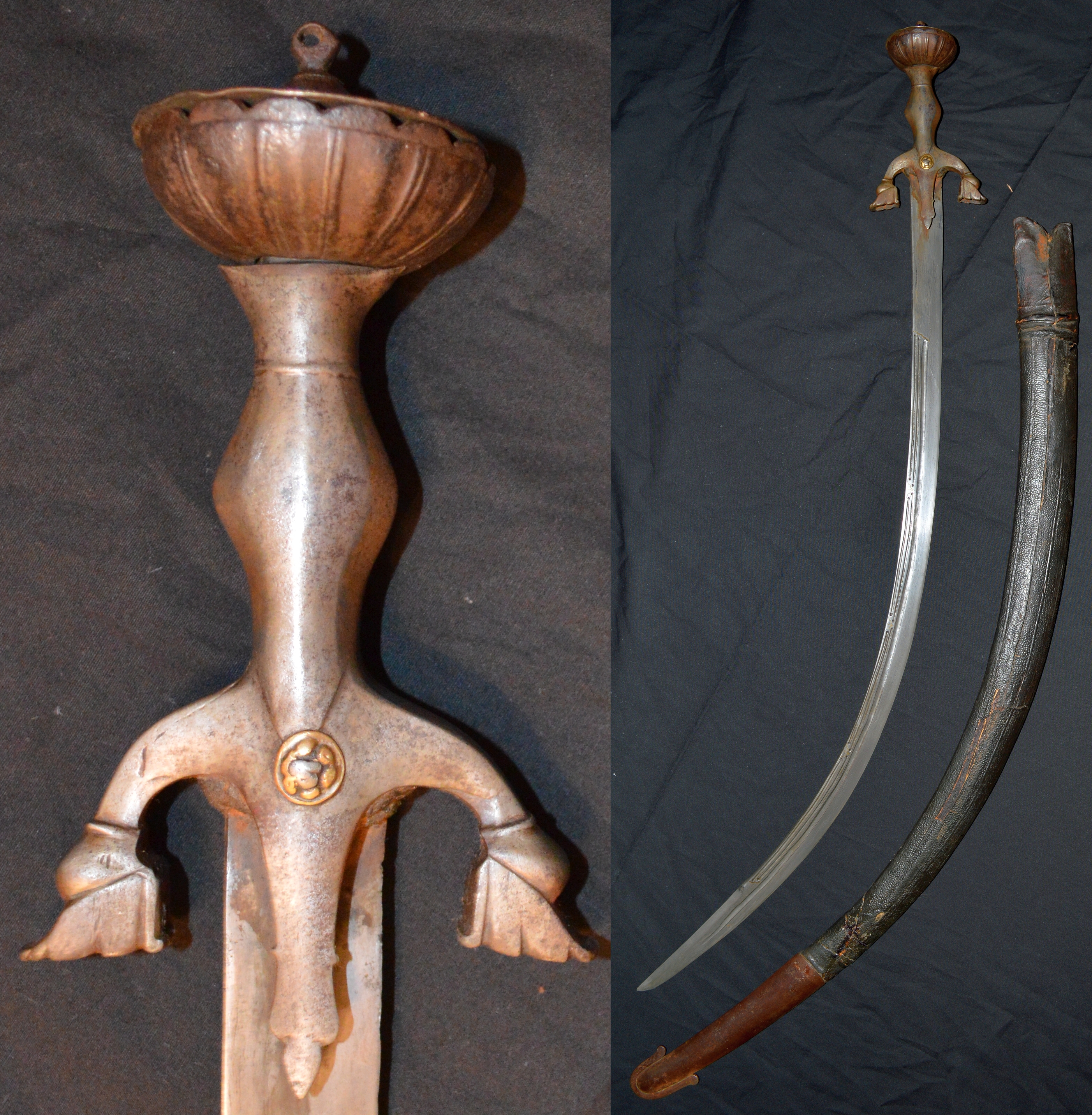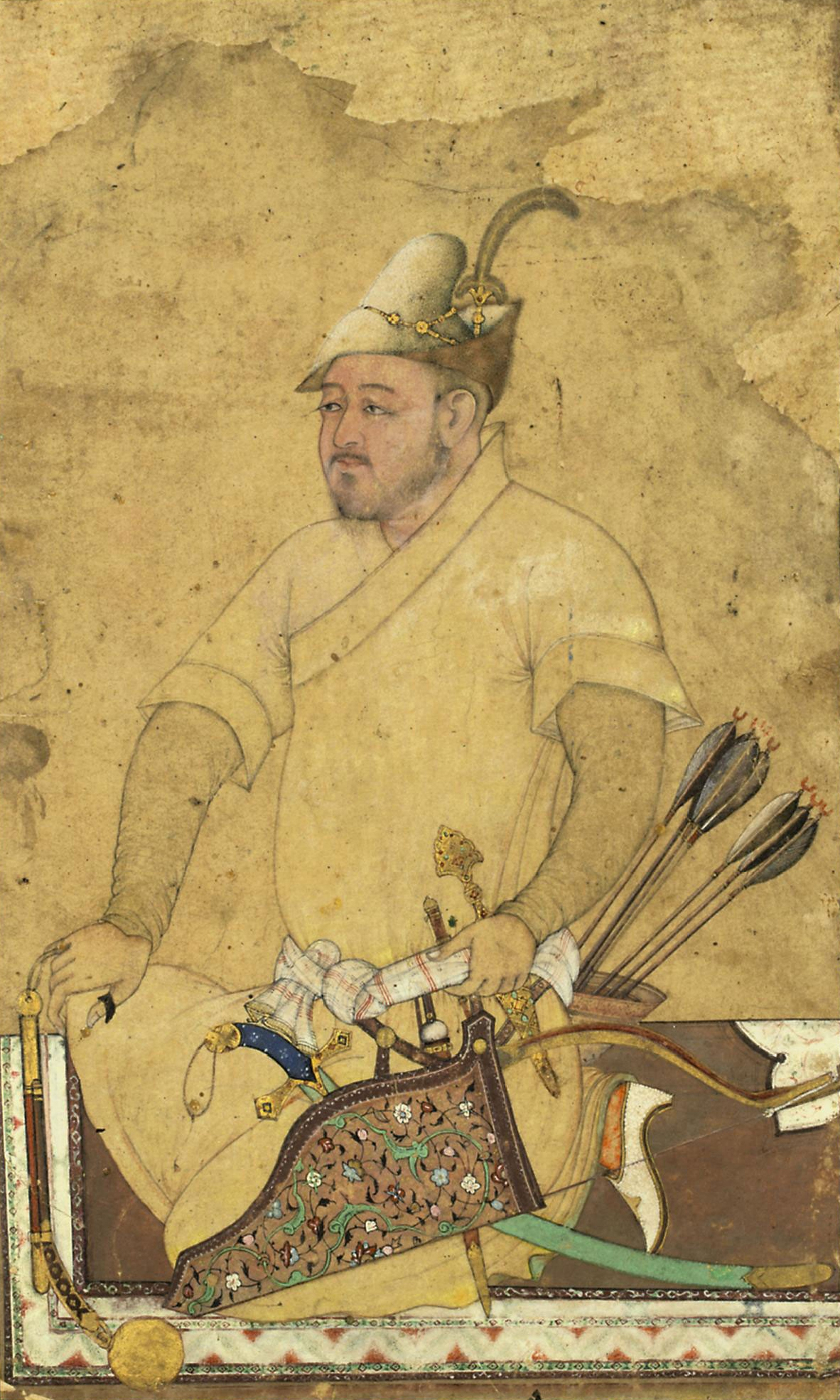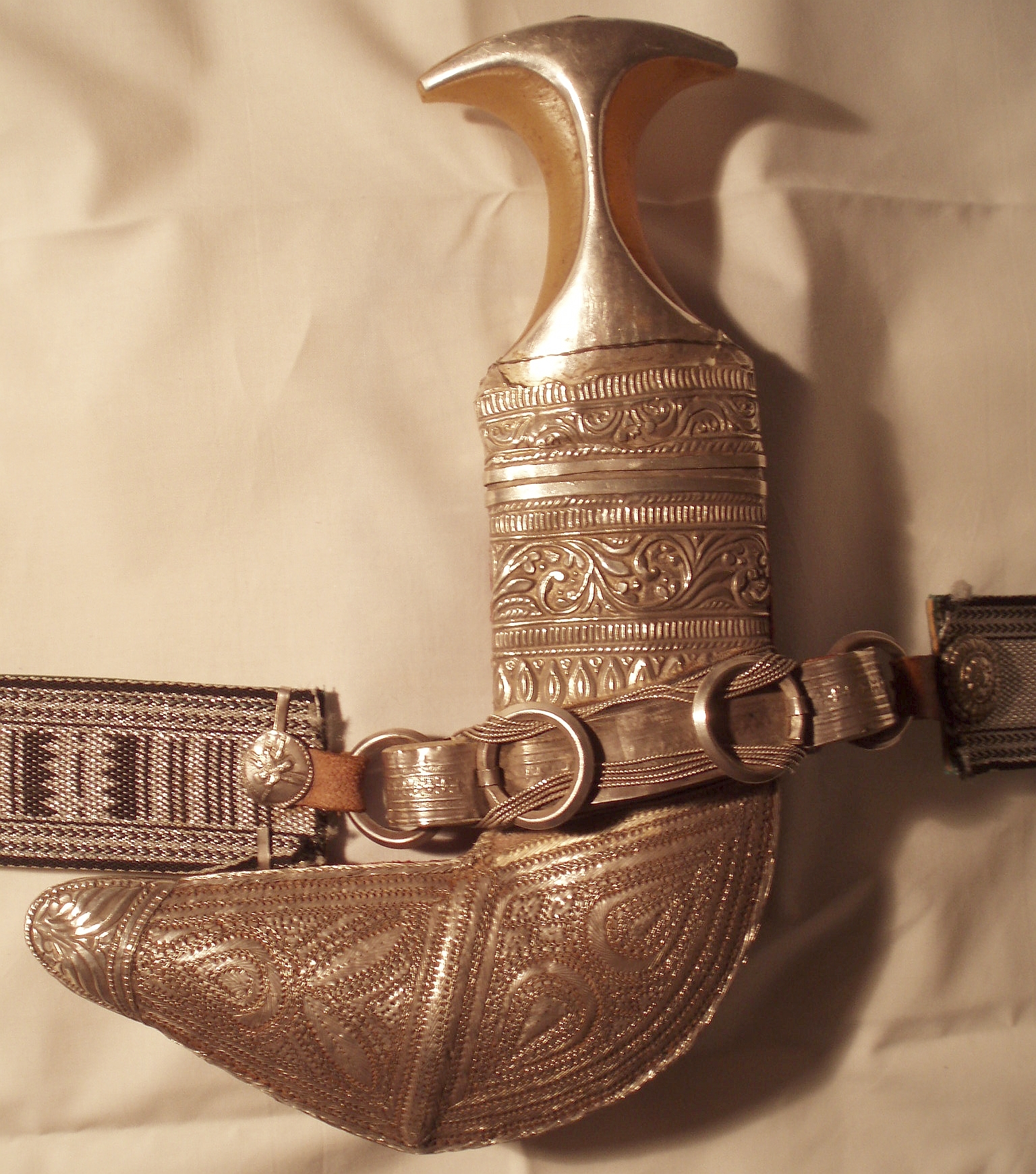|
Pulwar
The pulwar or pulouar is a single-handed curved sword originating in Afghanistan. Origin The pulwar originated alongside other scimitar-type weapons such as the Arab saif, the Persian shamshir, the Turkish kilij, and the Indian talwar, all of them ultimately based on earlier Central Asian swords. Originally, the Khyber Knife (a type of short sword) served as the weapon of the common people while upper-classes could afford to import swords from neighbouring Persia and India. Over time, the Afghans combined characteristics of the imported swords and adapted it to create the pulwar. Most existing pulwars date back to the early 19th century. Characteristics Borrowing features from the swords of neighboring lands, the pulwar may be described as an Afghan version of the Indian talwar. Pulwar blades tend to be more elaborately fullered than those of the talwar. Some pulwar hilts were fitted to Persian blades which are slimmer and more curved and tapered towards the tip than the more t ... [...More Info...] [...Related Items...] OR: [Wikipedia] [Google] [Baidu] |
Sabre
A sabre ( French: �sabʁ or saber in American English) is a type of backsword with a curved blade associated with the light cavalry of the early modern and Napoleonic periods. Originally associated with Central European cavalry such as the hussars, the sabre became widespread in Western Europe during the Thirty Years' War. Lighter sabres also became popular with infantry of the early 17th century. In the 19th century, models with less curving blades became common and were also used by heavy cavalry. The military sabre was used as a duelling weapon in academic fencing in the 19th century, giving rise to a discipline of modern sabre fencing (introduced in the 1896 Summer Olympics) loosely based on the characteristics of the historical weapon in that it allows for cuts as well as thrusts. Etymology The English ''sabre'' is recorded from the 1670s, as a direct loan from French, where the ''sabre'' is an alteration of ''sable'', which was in turn loaned from German ''Säbel'' ... [...More Info...] [...Related Items...] OR: [Wikipedia] [Google] [Baidu] |
Shamshir
A shamshir ( fa, شمشیر) is a type of Persian/Iranian sword with a radical curve. The name is derived from the Persian word ''shamshīr'', which means "sword". The curved "scimitar" sword family includes the shamshir, kilij, talwar, pulwar and nimcha. A ''shamshir shekargar'' ( fa, شمشیر شکارگر, shamshir-e shekârgar, lit=hunters' sword or hunting sword) is the same as a ''shamshir'', except the blade is engraved and decorated, usually with hunting scenes. Description Originally, Persian swords were straight and double edged. Curved Turko-Mongol sabers, sabre blades were Central Asian in origin. There is considerable disagreement between historians as to when these curved blades were first introduced from Central Asia into Iran, Persia, and over what period they became adopted and modified into the recognizable Shamshir. Curved blades began to appear in Persia in the 9th century, when these weapons were used by soldiers in the Greater Khorasan, Khorasan region of ... [...More Info...] [...Related Items...] OR: [Wikipedia] [Google] [Baidu] |
Kilij
A kilij (from Turkish ''kılıç'', literally "sword") or a pusat is a type of one-handed, single-edged and moderately curved scimitar used by the Seljuk Empire, Timurid Empire, Mamluk Empire, Ottoman Empire, and other Turkic khanates of Eurasian steppes and Turkestan. These blades developed from earlier Turko-Mongol sabers that were in use in lands controlled or influenced by the Turkic peoples. History Etymology According to Turkish Language Association, the Turkish root verb "''kır-''" which means "to kill" with the suffix "''-inç''" makes "''kır-ınç''" (instrument for killing) becomes ''kılınç'', then ''kılıç''. However, according to Turkish-Armenian linguist Sevan Nişanyan, it is derived from the Turkic root "''kıl-''" which means "to forge" or "to smith", with the diminutive suffix "''-ıç''" which creates "''kıl-ıç''" (roughly “ironwork”, i.e. “sword”). Also one of the earliest mentions of the word was also recorded as “kılıç” (“ ... [...More Info...] [...Related Items...] OR: [Wikipedia] [Google] [Baidu] |
Khanjar
A ''khanjar'' ( ar, خنجر, ku, Xencer, bn, খঞ্জর, khôñjôr tr, Hançer, fa, خنجر, ur, خنجر, sh, Handžar) is a traditional dagger originating from Oman, although it has since spread to the rest of the Middle East, South Asia, and the Balkans. Worn by men for ceremonial occasions, it is a short curved sword shaped like the letter "J" and resembles a hook. It can be made from a variety of different materials, depending on the quality of its craftsmanship. It is a popular souvenir among tourists and is sold in souqs throughout the region. A national symbol of the sultanate, the ''khanjar'' is featured on Oman's national emblem and on the Omani rial. It also features in logos and commercial imagery by companies based in Oman. History Although it is not known when the Omani ''khanjar'' was first created, rock carvings epitomizing the dagger were found on gravestones located in the central part of the Ru’us al Jibal region. These are believed to ... [...More Info...] [...Related Items...] OR: [Wikipedia] [Google] [Baidu] |
Z Pulwar Hilt
Z (or z) is the 26th and last letter of the Latin alphabet, used in the modern English alphabet, the alphabets of other western European languages and others worldwide. Its usual names in English are ''zed'' () and ''zee'' (), with an occasional archaic variant ''izzard'' ()."Z", ''Oxford English Dictionary,'' 2nd edition (1989); ''Merriam-Webster's Third New International Dictionary of the English Language, Unabridged'' (1993); "zee", ''op. cit''. Name and pronunciation In most English-speaking countries, including Australia, Canada, India, Ireland, New Zealand and the United Kingdom, the letter's name is ''zed'' , reflecting its derivation from the Greek ''zeta'' (this dates to Latin, which borrowed Y and Z from Greek), but in American English its name is ''zee'' , analogous to the names for B, C, D, etc., and deriving from a late 17th-century English dialectal form. Another English dialectal form is ''izzard'' . This dates from the mid-18th century and probably derives fr ... [...More Info...] [...Related Items...] OR: [Wikipedia] [Google] [Baidu] |
Hilt
The hilt (rarely called a haft or shaft) of a knife, dagger, sword, or bayonet is its handle, consisting of a guard, grip and pommel. The guard may contain a crossguard or quillons. A tassel or sword knot may be attached to the guard or pommel. Pommel The pommel (Anglo-Norman "little apple") is an enlarged fitting at the top of the handle. They were originally developed to prevent the sword from slipping from the hand. From around the 11th century in Europe they became heavy enough to be a counterweight to the blade. This gave the sword a point of balance not too far from the hilt allowing a more fluid fighting style. Depending on sword design and swordsmanship style, the pommel may also be used to strike the opponent (e.g., using the Mordhau technique). Pommels have appeared in a wide variety of shapes, including oblate spheroids, crescents, disks, wheels, and animal or bird heads. They are often engraved or inlayed with various designs and occasionally gilt and mou ... [...More Info...] [...Related Items...] OR: [Wikipedia] [Google] [Baidu] |
Weapons Of Afghanistan
A weapon, arm or armament is any implement or device that can be used to deter, threaten, inflict physical damage, harm, or kill. Weapons are used to increase the efficacy and efficiency of activities such as hunting, crime, law enforcement, self-defense, warfare, or suicide. In broader context, weapons may be construed to include anything used to gain a tactical, strategic, material or mental advantage over an adversary or enemy target. While ordinary objects – sticks, rocks, bottles, chairs, vehicles – can be used as weapons, many objects are expressly designed for the purpose; these range from simple implements such as clubs, axes and swords, to complicated modern firearms, tanks, intercontinental ballistic missiles, biological weapons, and cyberweapons. Something that has been re-purposed, converted, or enhanced to become a weapon of war is termed weaponized, such as a weaponized virus or weaponized laser. History The use of weapons is a major driver of cultural ... [...More Info...] [...Related Items...] OR: [Wikipedia] [Google] [Baidu] |
Zulfiqar
Zulfiqar ( ar, ذُو ٱلْفَقَار, Ḏū-l-Faqār, ), also spelled ''Zu al-Faqar'', ''Zulfikar'', ''Dhu al-Faqar'', ''Dhulfaqar'' or ''Dhulfiqar'', is the sword of Ali ibn Abi Talib. Middle Eastern weapons are commonly inscribed with a quote mentioning Zulfiqar, and Middle Eastern swords are at times made with a split tip in reference to the weapon. Name The meaning of the name is uncertain. The word ''ḏhu'' () means "possessor, master", and the idafa construction "possessor of..." is common in Arabic phraseology, such as in ''Dhu al-Qarnayn'', ''Dhu al-Kifl'', ''Dhu al-Qadah'' and ''Dhu al-Hijjah''. The meaning of ''faqār'' (), means "splitter, differentiatior". It is often vocalized as ''fiqār'' instead of ''faqār''; Lane cites authorities preferring ''faqār'' however the vocalization ''fiqār'' still sees more widespread use. The word ''faqār'' has the meaning of "the vertebrae of the back, the bones of the spine, which are set in regular order, one upon ... [...More Info...] [...Related Items...] OR: [Wikipedia] [Google] [Baidu] |
Qajar
Qajar Iran (), also referred to as Qajar Persia, the Qajar Empire, '. Sublime State of Persia, officially the Sublime State of Iran ( fa, دولت علیّه ایران ') and also known then as the Guarded Domains of Iran ( fa, ممالک محروسه ایران '), was an Iranian state ruled by the Qajar dynasty, which was of Turkic origin,Cyrus Ghani. ''Iran and the Rise of the Reza Shah: From Qajar Collapse to Pahlavi Power'', I. B. Tauris, 2000, , p. 1William Bayne Fisher. ''Cambridge History of Iran'', Cambridge University Press, 1993, p. 344, Dr Parviz Kambin, ''A History of the Iranian Plateau: Rise and Fall of an Empire'', Universe, 2011, p.36online edition specifically from the Qajar tribe, from 1789 to 1925.Abbas Amanat, ''The Pivot of the Universe: Nasir Al-Din Shah Qajar and the Iranian Monarchy, 1831–1896'', I. B. Tauris, pp 2–3; "In the 126 years between the fall of the Safavid state in 1722 and the accession of Nasir al-Din Shah, the Qajars evolved from a ... [...More Info...] [...Related Items...] OR: [Wikipedia] [Google] [Baidu] |
Hilt
The hilt (rarely called a haft or shaft) of a knife, dagger, sword, or bayonet is its handle, consisting of a guard, grip and pommel. The guard may contain a crossguard or quillons. A tassel or sword knot may be attached to the guard or pommel. Pommel The pommel (Anglo-Norman "little apple") is an enlarged fitting at the top of the handle. They were originally developed to prevent the sword from slipping from the hand. From around the 11th century in Europe they became heavy enough to be a counterweight to the blade. This gave the sword a point of balance not too far from the hilt allowing a more fluid fighting style. Depending on sword design and swordsmanship style, the pommel may also be used to strike the opponent (e.g., using the Mordhau technique). Pommels have appeared in a wide variety of shapes, including oblate spheroids, crescents, disks, wheels, and animal or bird heads. They are often engraved or inlayed with various designs and occasionally gilt and mou ... [...More Info...] [...Related Items...] OR: [Wikipedia] [Google] [Baidu] |
Fuller (weapon)
A fuller is a rounded or beveled longitudinal groove or slot along the flat side of a blade (e.g., a sword, knife, or bayonet) that serves to both lighten and stiffen the blade. It is made using a blacksmithing tool called a fuller, a form of a spring swage, or impressed during forging. When combined with proper distal tapers, heat treatment and blade tempering, a fullered blade can be 20% to 35% lighter than a non-fullered blade, yet also stiffer, thanks to having two reinforcing ridges created by the opposing sides of the fuller. This stiffening effect increases dramatically with blade length. A fuller is often used to widen a blade during smithing or forging. Fullers are sometimes inaccurately called blood grooves or blood gutters. Channelling blood is not the purpose of a fuller. Etymology The term "fuller" is from the Old English ''fuliere'', meaning 'one that fulls leatscloth'. It is derived from the Latin word ''fullo''. The first recorded use of the term in relati ... [...More Info...] [...Related Items...] OR: [Wikipedia] [Google] [Baidu] |
Iran
Iran, officially the Islamic Republic of Iran, and also called Persia, is a country located in Western Asia. It is bordered by Iraq and Turkey to the west, by Azerbaijan and Armenia to the northwest, by the Caspian Sea and Turkmenistan to the north, by Afghanistan and Pakistan to the east, and by the Gulf of Oman and the Persian Gulf to the south. It covers an area of , making it the 17th-largest country. Iran has a population of 86 million, making it the 17th-most populous country in the world, and the second-largest in the Middle East. Its largest cities, in descending order, are the capital Tehran, Mashhad, Isfahan, Karaj, Shiraz, and Tabriz. The country is home to one of the world's oldest civilizations, beginning with the formation of the Elamite kingdoms in the fourth millennium BC. It was first unified by the Medes, an ancient Iranian people, in the seventh century BC, and reached its territorial height in the sixth century BC, when Cyrus the Great fo ... [...More Info...] [...Related Items...] OR: [Wikipedia] [Google] [Baidu] |






.jpg)